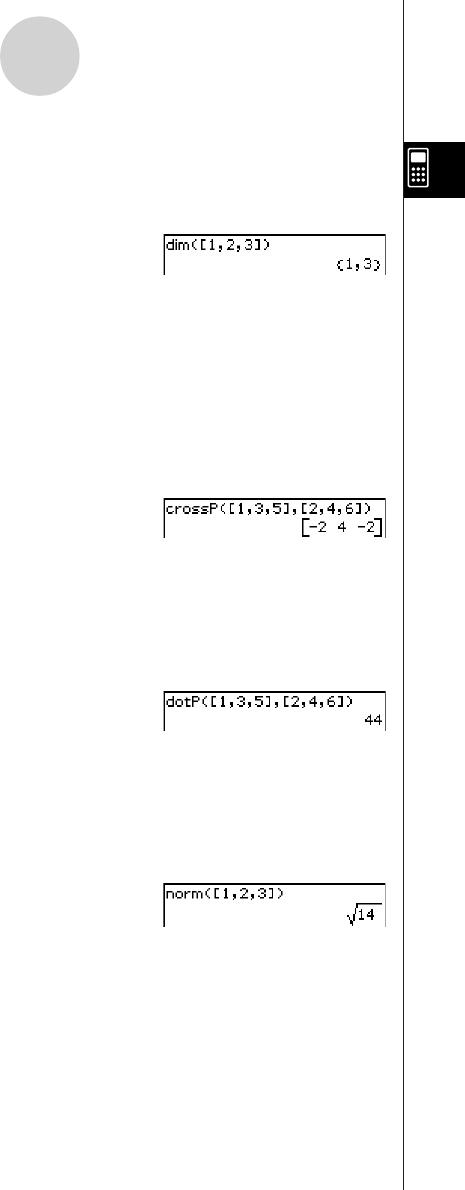User Guide
Table Of Contents
- Getting Ready
- Contents
- About This User’s Guide
- Chapter 1 Getting Acquainted
- Chapter 2 Using the Main Application
- 2-1 Main Application Overview
- 2-2 Basic Calculations
- 2-3 Using the Calculation History
- 2-4 Function Calculations
- 2-5 List Calculations
- 2-6 Matrix and Vector Calculations
- 2-7 Using the Action Menu
- 2-8 Using the Interactive Menu
- 2-9 Using the Main Application in Combination with Other Applications
- 2-10 Using Verify
- Chapter 3 Using the Graph & Table Application
- Chapter 4 Using the Conics Application
- Chapter 5 Using the 3D Graph Application
- Chapter 6 Using the Sequence Application
- Chapter 7 Using the Statistics Application
- 7-1 Statistics Application Overview
- 7-2 Using List Editor
- 7-3 Before Trying to Draw a Statistical Graph
- 7-4 Graphing Single-Variable Statistical Data
- 7-5 Graphing Paired-Variable Statistical Data
- 7-6 Using the Statistical Graph Window Toolbar
- 7-7 Performing Statistical Calculations
- 7-8 Test, Confidence Interval, and Distribution Calculations
- 7-9 Tests
- 7-10 Confidence Intervals
- 7-11 Distribution
- 7-12 Statistical System Variables
- Chapter 8 Using the Geometry Application
- Chapter 9 Using the Numeric Solver Application
- Chapter 10 Using the eActivity Application
- Chapter 11 Using the Presentation Application
- Chapter 12 Using the Program Application
- Chapter 13 Using the Spreadsheet Application
- Chapter 14 Using the Setup Menu
- Chapter 15 Configuring System Settings
- 15-1 System Setting Overview
- 15-2 Managing Memory Usage
- 15-3 Using the Reset Dialog Box
- 15-4 Initializing Your ClassPad
- 15-5 Adjusting Display Contrast
- 15-6 Configuring Power Properties
- 15-7 Specifying the Display Language
- 15-8 Specifying the Font Set
- 15-9 Specifying the Alphabetic Keyboard Arrangement
- 15-10 Optimizing “Flash ROM”
- 15-11 Specifying the Ending Screen Image
- 15-12 Adjusting Touch Panel Alignment
- 15-13 Viewing Version Information
- Chapter 16 Performing Data Communication
- Appendix

20050501
uu
uu
u dim
Function: Returns the dimension of a vector.
Syntax: dim (Mat [
)
]
Example: To determine the dimension of the vector [1, 2, 3]
Menu Item: [Action][Vector][dim]
• The vector [1,2,3] is handled as a 1 × 3 matrix.
uu
uu
u crossP
Function: Returns the cross product of two vectors.
Syntax: crossP (Mat-1, Mat-2 [
)
]
• This command can be used with a 1 × N or N × 1 matrix only (N = 2, 3).
•A two-element matrix [a, b] or [[a], [b]] is automatically converted into a three-element
matrix [a, b, 0] or [[a], [b], [0]].
Example: To obtain the cross product of the two vectors [1, 3, 5] and [2, 4, 6]
Menu Item: [Action][Vector][crossP]
uu
uu
u dotP
Function: Returns the dot product of two vectors.
Syntax: dotP (Mat-1, Mat-2 [
)
]
• This command can be used with a 1 × N or N × 1 matrix only.
Example: To obtain the dot product of the two vectors [1, 3, 5] and [2, 4, 6]
Menu Item: [Action][Vector][dotP]
uu
uu
u norm
Function: Returns the norm of a vector.
Syntax: norm (Mat [
)
]
Example: To obtain the norm of the vector [1, 2, 3]
Menu Item: [Action][Vector][norm]
2-7-37
Using the Action Menu










